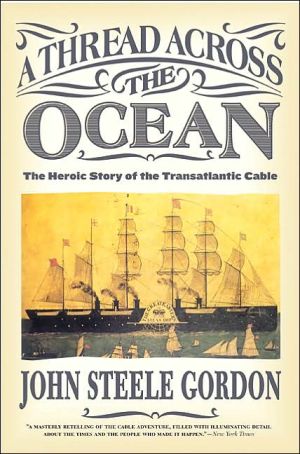Thread Across the Ocean
Today, in a world in which news flashes around the globe in an instant, time lags are inconceivable. In the mid-nineteenth century, communication between the United States and Europe — the center of world affairs — was only as quick as the fastest ship could cross the Atlantic, making the United States isolated and vulnerable.\ But in 1866, the Old and New Worlds were united by the successful laying of a cable across the Atlantic. John Steele Gordon's book chronicles this extraordinary...
Search in google:
Before the intervention of the electronic telegraph, news moved at the speed of humans or, in the case of information crossing the Atlantic Ocean, at the speed of ships. American businessman Cyrus Field is give the lion's share of the credit for changing that situation in this work describing his twelve years and five attempts at laying the transatlantic cable between Newfoundland and Ireland. The failures and successes of Field's activities are here recounted in a narrative that focuses equally on problems of technology and problems of business. This is a paper edition reprint of a 2002 book. Annotation ©2004 Book News, Inc., Portland, OR Publishers Weekly Most of us don't think twice about picking up the phone and reaching someone in Germany in a matter of seconds. We often forget that less than 150 years ago, if one wanted to do business in Europe, one got on a boat for two weeks because the only way to do business was in person. Perhaps the biggest force in making worldwide commerce relatively simple was the laying of the transatlantic cable in 1866, which made communication first via telegraph, then by phone possible. American Heritage writer Gordon (The Business of America) chronicles the quest to lay the cable, offering a fascinating account that will appeal to history buffs and businesspersons alike. On one level, it's a purely historical account of the battle to navigate the ocean's floor and to figure out not only what should be inside the cable but also how to keep it in place. On another level, by focusing on entrepreneur Cyrus Field, the author traces what was in essence a venture capital deal. He begins with Field gathering wealthy investors the initial funding was equal to 2.5% of the entire federal budget and ends, after 12 years and five distinct failures, with all of them striking it rich. This is an appealing account on both levels and an entertaining reminder of the storied past of expensive technology gambles. Illus. Agent, Katinka Matson. (July) Copyright 2002 Cahners Business Information.
A Thread Across the Ocean\ The Heroic Story of the Transatlantic Cable \ \ By John Gordon\ Harper Collins Publishers\ Copyright © 2003 John Gordon All right reserved. ISBN: 0060524464 \ \ Chapter One\ "An Enterprise Worthy of This Day of Great Things"\ \ Thomas Nightingale had prospered in South Carolina almost from the day he had arrived as a young man from his native Yorkshire in the 1720s. He got his start operating a cow pen on the frontier but soon branched into numerous other activities, including building Newmarket Race Track in Charleston and importing some of the first thoroughbred horses to the North American colonies.\ The timing of his arrival had been fortunate. Trade in rice and indigo was fast making the Carolina tidewater the richest part of the British North American empire, and Thomas Nightingale grew rich right along with his adopted land.\ In 1760, already well established among Charleston's aristocracy, he decided to add one more proof of his status in that very status-conscious society. He bought a pew, number 101, in St. Michael's Church, then under construction in Charleston. With the great wealth at the congregation's disposal, little expense had been spared in the building of St. Michael's, a masterpiece of American colonial architecture. Much of the woodwork, for instance, would be supplied by Thomas Elfe, the city's leading cabinetmaker and himself apew holder. A pew in such a church did not come cheaply. But for fifty pounds - more than a workman's annual wage in the middle of the eighteenth century - Thomas Nightingale received a deed to the pew, signed and sealed by the church commissioners.\ That deed, to our eyes, has one very curious aspect. It is dated "the fifth day of December in the Year of our Lord One Thousand Seven Hundred and Sixty and in the Thirty-Fourth year of the Reign of our Sovereign Lord King GEORGE the Second ... " But George II had died suddenly of a burst blood vessel on October 25, 1760, while in his water closet. December 5, therefore, was in fact in the first year of the reign of his grandson, King George III.\ It is a measure of the perceived vastness of the Atlantic Ocean in the eighteenth century that the king's richest North American possession remained ignorant of his death a full six weeks after the event. Charleston, in fact, did not learn of the king's death for another two weeks or more.\ Yet America's civilization and character developed during the colonial period in the context of this profound isolation from its European roots. In 1620, the Mayflower had sailed from Plymouth, in Devonshire, on September 16, and raised Cape Cod only on November 9. That was considered a very good passage at the time, and in fact it was still a good passage two hundred years later. It was by no means unprecedented for a ship unfortunate in weather to take four months to make the trip from the Old World to the New.\ Because the trip was so long, expensive, and perilous, only a handful of immigrants to the New World - mostly members of the colonies' business and political elites - ever had the opportunity to return to the Old. Thus, to set sail for America in the seventeenth and eighteenth centuries was, almost always, to say good-bye forever to all the emigrant had known and loved.\ Since for all practical purposes news could travel no faster than human beings could carry it, knowledge of events in Europe - the center of the Western world - was just as slow to flow across the ocean as men and goods. North America was not only three thousand miles from Europe - it was two months from it as well. There was not even a regular postal system; letters were entrusted to anyone willing to carry them, to be delivered when and if possible.\ Today, such isolation is almost inconceivable. After all, it took the Apollo astronauts only three days to reach the moon, a distance almost a hundred times as great as the width of the Atlantic, and news from the moon (not, to be sure, that there is much) could reach us in seconds.\ But in Thomas Nightingale's day, the vast gulf between Europe and America was simply a fact of life. Like growing old, or needing to sleep for several hours a day, it was taken as a given, if sometimes regretted.\ But even as King George lay dying in his water closet, many of his subjects, especially in the Midlands of England, were already deeply involved in a process that would profoundly alter the boundaries of what was possible. The cloth industry, for example, a mainstay of the British economy for centuries, had begun to mechanize, adopting the factory system of manufacture, which would come to dominate the world economy. John Kay's flying shuttle, introduced in 1733, considerably increased the speed with which cloth could be woven. The spinning jenny and the water frame, introduced in the 1760s, greatly accelerated the manufacture of yarn. The power loom in the 1780s completed the mechanization of the industry.\ At first these machines were powered by falling water pushing on mill wheels. Then, in 1769, the Scotsman James Watt patented a greatly improved steam engine, and in 1784 introduced a rotary version, capable of turning a shaft. The new power source, which made work-doing energy both cheap and capable of being applied in almost unlimited amounts to a single task, proved the catalyst of profound change. Dubbed the Industrial Revolution in 1848 (when it was already almost a century old), it swept away the world of Thomas Nightingale and George II in a matter of two generations and created the modern world.\ Politics helped. With the final defeat of Napoleon at the Battle of Waterloo, on June 16, 1815, the Western world entered into a period of peace that would last nearly a hundred years, until the outbreak of the First World War on August 1, 1914. In this period of relative peace, with the exception of the American Civil War, wars were mostly short and often distant from the centers of Western civilization ...\ (Continues...)\ \ \ \ \ Excerpted from A Thread Across the Ocean by John Gordon\ Copyright © 2003 by John Gordon\ Excerpted by permission. All rights reserved. No part of this excerpt may be reproduced or reprinted without permission in writing from the publisher.\ \
A Note on MoneyxiAcknowledgmentsxiiiI"An Enterprise Worthy of This Day of Great Things"1IICyrus Field14IIINewfoundland28IV"How Many Months? Let's Say How Many Years!"47VRaising More Capital61VIThe First Cable75VII"And Lay the Atlantic Cable in a Heap"100VIIILightning Through Deep Waters121IX"Here's the Ship to Lay Your Cable, Mr. Field"142XA New Cable, a New Attempt163XI"The Great Eastern Looms All Glorious in the Morning Sky"187Epilogue--"There Were Two Worlds ... Let There Be One"209Notes217Bibliography225Index229








